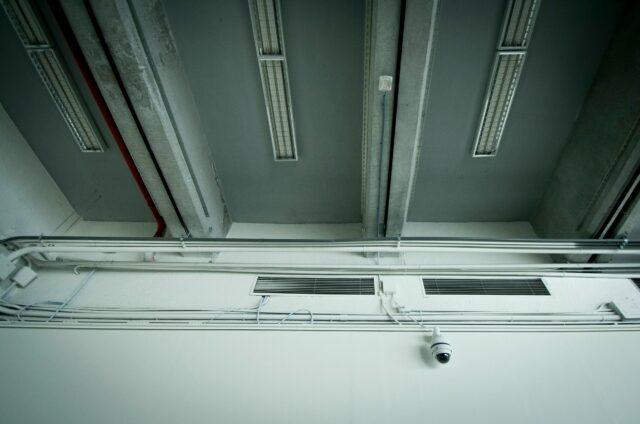Can a thermal camera see through smoke or fog?

Get Special Offers Now for Locksmith Services Call Us Now at 02081458426
In recent years, thermal cameras have gained substantial popularity due to their capacity to detect infrared radiation emitted by objects, translating it into visible images. This technology boasts a broad spectrum of applications, from security and firefighting to everyday use. A joint inquiry regarding thermal cameras revolves around their ability to see through smoke or fog. This article delves into the intricacies of this question to provide a comprehensive understanding.
Thermal cameras operate by identifying the heat signatures emitted by objects. Their functionality centers on capturing the infrared radiation from objects with temperatures above absolute zero (-273.15°C or -459.67°F). This radiation features longer wavelengths than visible light, allowing it to traverse certain materials, including smoke and fog, which visible light struggles to penetrate.
Smoke and fog are prevalent atmospheric conditions that can severely impair visibility. In scenarios like firefighting, smoke can obscure the sightlines of firefighters, impeding their ability to locate individuals or navigate structures. Similarly, fog can drastically reduce road visibility, posing challenges for drivers in recognizing other vehicles or obstacles. Thermal cameras prove advantageous in such situations by piercing through smoke and fog, detecting objects that would otherwise remain concealed to the naked eye. Explore the types of thermal imaging cameras capable of penetrating smoke and fog.

Making full use of the InfiRay IR-Pilot Automotive Infrared Camera amid rainy situations can help curb crashes blamed on compromised sight. Yet, it’s essential to grasp that heat cameras aren’t miraculous machines able to pierce any level of smoke or mist. Their abilities have boundaries and rely on various aspects, like the thickness of the smoke or mist veil, the temperatures of things hidden by the smoke or mist, and the sensitivity of the heat camera itself.
The power of a heat viewer can be lessened within a place heavily clouded by smoke. Smog consists of tiny pieces of carbon, water, and other things that take in and distribute the infrared light given off by objects. As smog thickness increases, less infrared light arrives at the heat viewer, decreasing its ability to detect things past the smog layer.
Additionally, the warmth of items concealed by smoke or haze can influence the warmth camera’s capability to spot. Things more incredible than what’s around them will give off fewer infrared rays, making them tougher to notice. In contrast, items hotter than what’s around them will emit higher levels of infrared rays, making them simpler to notice.

Though hazy conditions veiled outer structures, the InfiRay thermal optics persisted in distinguishing far-off constructions.
Another issue affecting a thermal camera’s performance is its effectiveness in registering slight temperature differences. Some thermal cameras can identify even minor warmth changes, making them more helpful when visibility is low. However, enhanced performance regularly requires a higher price and may not be necessary for every use. Find out where to get the InfiRay IR-Pilot Automotive Infrared Camera, assistance for driving in foggy or wet weather.
While certain constraints exist, devices that identify heat offer noteworthy assistance in mist or vapor conditions. A key benefit is their means to spot variations in warmth between things. This quality is essential in firefighting missions, wherein those responding must find folks potentially caught inside smoky buildings full of smoke. Learn more about how the InfiRay Thermal Camera can shield storerooms from flames.
Within a smoke-filled setting, a heat-detecting lens could single out the temperature prints of things past the smoke layer, like the person. This was possible because the person gives off significant unseen warmth, even through thick smoke. The heat-detecting lens records this warmth, making a photo of the person’s temperature outline, thus helping firefighters locate and save individuals.
In addition, cameras that sense temperature outperform the unaided human perspective in uncovering glowing fires unseen by bare sight. Mechanisms or hardware emanating warmth in industrial structures can be a forerunner to flames. Sensors skilled in spotting the thermal signatures of these glowing areas empower upkeep employees to pinpoint likely dangers and take remedial actions before a fire happens.

Within commercial fire safeguarding, InfiRay heat-sensing cameras are remarkably worthwhile.
Devices sensitive to infrared radiation allow versatile uses with limited visibility, like search and recovery tasks, monitoring, and patrolling. In search and recovery efforts, instruments detecting thermal radiation are crucial in pinpointing lost or hurt persons in remote areas. They can locate individuals needing aid even when obscured by thick fog common in wooded zones. By noticing the thermal imprint of a being’s physique, instruments perceiving thermal radiation surmount obstacles like trees, significantly raising the chance of successful recoveries.
Patrol uses warmth detectors to show their helpfulness by finding those aiming to sneak into the checked region. The warmth from a person’s body can be seen by the warmth camera, even if hidden in plants or shelters. This skill aids patrol workers in capturing individuals who are wrongly attempting to enter the area, even depending on things like rain, snow, or fog as a disguise.
While devices that detect heat can somewhat see through smoke and fog, how well they work relies on different things. These factors include how thick the smoke or fog is, how warm objects are hidden by smoke or fog, and how sensitive the heat-detecting camera is. Despite these limits, heat-detecting cameras are beneficial when it’s hard to see, like fighting fires, searching for people or animals, and patrolling areas. Learn more about InfiRay’s Thermal Imaging Solution for Forest Fire Prevention that can see in the dark.

The InfiRay cameras skillfully spotted hillside blazes.
Whether you are considering obtaining a heat-seeing device for any of the reasons described, choosing one customized for your needs is essential. Things to assess the camera’s perceptiveness, clarity, and toughness. Suitability with present gear or programs should also be thought about.
Thermal equipment provides noteworthy worth across differing fields, offering priceless understandings in conditions described by restricted perception. Even though they might not universally act as a magic remedy for viewing through vapor and haze, they can current an assortment of feasible solutions for various employments. Leading extensive investigation is most important for anybody considering a thermal camera buy to guarantee the camera coordinates with your specific necessities.
Frequently Asked Questions
Can thermal cameras effectively see through smoke and fog?
Thermal cameras can see through smoke and fog to a certain extent. However, their effectiveness can be influenced by factors like the density of the smoke or fog layer, the temperature of objects behind the smoke or fog, and the camera’s sensitivity. While they offer enhanced visibility in challenging conditions, they are not a magic solution and have limitations.
How can thermal cameras be useful in firefighting and search and rescue operations?
Thermal cameras are crucial in firefighting and search and rescue scenarios. They can detect heat signatures emitted by objects, including the human body, through smoke or fog. This ability aids firefighters in locating individuals trapped within smoke-filled buildings or assisting search and rescue teams in finding lost or injured individuals in remote areas.
What factors should be considered when choosing a thermal camera for specific applications?
When selecting a thermal camera, several factors come into play. These include the camera’s sensitivity, resolution, and durability. It’s also essential to ensure compatibility with existing equipment or software. Choosing a camera tailored to your needs will enhance its effectiveness in your intended applications.
How influential are thermal cameras in industries with limited visibility scenarios?
Thermal cameras hold substantial importance across industries where visibility is compromised. They provide valuable insights into firefighting, surveillance, and patrolling situations. While they don’t offer an all-encompassing solution for seeing through smoke and fog, they offer versatile solutions for various applications by detecting heat signatures and temperature differences. Conduct thorough research before purchasing to ensure the chosen thermal camera meets your needs.


